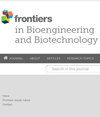

Journal Title:Frontiers In Bioengineering And Biotechnology
The translation of new discoveries in medicine to clinical routine has never been easy. During the second half of the last century, thanks to the progress in chemistry, biochemistry and pharmacology, we have seen the development and the application of a large number of drugs and devices aimed at the treatment of symptoms, blocking unwanted pathways and, in the case of infectious diseases, fighting the micro-organisms responsible. However, we are facing, today, a dramatic change in the therapeutic approach to pathologies and diseases. Indeed, the challenge of the present and the next decade is to fully restore the physiological status of the diseased organism and to completely regenerate tissue and organs when they are so seriously affected that treatments cannot be limited to the repression of symptoms or to the repair of damage. This is being made possible thanks to the major developments made in basic cell and molecular biology, including stem cell science, growth factor delivery, gene isolation and transfection, the advances in bioengineering and nanotechnology, including development of new biomaterials, biofabrication technologies and use of bioreactors, and the big improvements in diagnostic tools and imaging of cells, tissues and organs.
In today`s world, an enhancement of communication between multidisciplinary experts, together with the promotion of joint projects and close collaborations among scientists, engineers, industry people, regulatory agencies and physicians are absolute requirements for the success of any attempt to develop and clinically apply a new biological therapy or an innovative device involving the collective use of biomaterials, cells and/or bioactive molecules. “Frontiers in Bioengineering and Biotechnology” aspires to be a forum for all people involved in the process by bridging the gap too often existing between a discovery in the basic sciences and its clinical application.
将医学新发现转化为临床常规从未如此简单。在上个世纪下半叶,由于化学、生物化学和药理学的进步,我们看到了大量旨在治疗症状、阻断不需要的途径以及在遇上传染病,抗击微生物负有责任。然而,今天,我们正面临着病理和疾病治疗方法的巨大变化。事实上,当前和未来十年的挑战是完全恢复患病生物体的生理状态,并在组织和器官受到严重影响时完全再生,以至于治疗不能仅限于抑制症状或修复损害。这要归功于基础细胞和分子生物学的重大发展,包括干细胞科学、生长因子递送、基因分离和转染、生物工程和纳米技术的进步,包括新生物材料的开发、生物制造技术和使用生物反应器,以及细胞、组织和器官的诊断工具和成像方面的重大改进。
在当今世界,加强多学科专家之间的交流,促进科学家、工程师、行业人士、监管机构和医生之间的联合项目和密切合作,是任何尝试成功开发的绝对必要条件并在临床上应用涉及集体使用生物材料、细胞和/或生物活性分子的新生物疗法或创新设备。 “生物工程和生物技术前沿”旨在通过弥合基础科学发现与其临床应用之间经常存在的差距,成为参与该过程的所有人的论坛。
| 大类学科 | 小类学科 | 分区 | Top期刊 | 综述期刊 |
| 工程技术 | MULTIDISCIPLINARY SCIENCES 综合性期刊 | 2区 | 是 | 是 |
| 大类学科 | 小类学科 | 分区 |
| 工程技术 | MULTIDISCIPLINARY SCIENCES 综合性期刊 | 2区 |
| 期刊名称 | 领域 | 中科院分区 | 影响因子 |
| Geomechanics For Energy And The Environment | 工程技术 | 2区 | 5.100 |
| Artificial Cells Nanomedicine And Biotechnology | 工程技术 | 2区 | 5.800 |
| Ieee Journal On Emerging And Selected Topics In Circuits And Systems | 工程技术 | 2区 | 4.600 |
| Research In Engineering Design | 工程技术 | 2区 | 3.200 |
| Engineering Science And Technology-an International Journal-jestech | 工程技术 | 2区 | 5.700 |
| International Journal Of Lean Six Sigma | 工程技术 | 2区 | 4.000 |